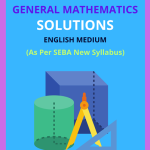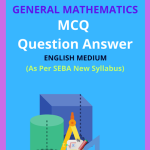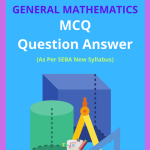SEBA Class 9 Mathematics Chapter 5 Introduction to Euclid’s Geometry Solutions, SEBA Class 9 Maths Textbook Notes in English Medium, SEBA Class 9 Mathematics Chapter 5 Introduction to Euclid’s Geometry Solutions in English to each chapter is provided in the list so that you can easily browse throughout different chapter Assam Board SEBA Class 9 Mathematics Chapter 5 Introduction to Euclid’s Geometry Notes and select needs one.
SEBA Class 9 Mathematics Chapter 5 Introduction to Euclid’s Geometry
Also, you can read the SCERT book online in these sections Solutions by Expert Teachers as per SCERT (CBSE) Book guidelines. SEBA Class 9 Mathematics Chapter 5 Introduction to Euclid’s Geometry Question Answer. These solutions are part of SCERT All Subject Solutions. Here we have given SEBA Class 9 Mathematics Chapter 5 Introduction to Euclid’s Geometry Solutions for All Subject, You can practice these here.
Introduction to Euclid’s Geometry
Chapter – 5
| Exercise 5.1 |
1. Which of the following statements are true and which are false? Give reasons for your answers.
(i) Only one line can pass through a single point.
Ans: False, from one point an infinite number of lines can pass.
(ii) There are an infinite number of lines which pass through two dis-tinct points.
Ans: False, as from two distinct points only one line can pass through them.
(iii) A terminated line can be produced indefinitely on both sides.
Ans: True, as you can see in the figure.
(iv) If two circles are equal then their radii are equal.
Ans: True, if two circles are equal then their centre and circumference will coincide. Therefore, radii will be equal.
(v) In fig. 5.21, If AB = PQ and PQ = XY then AB = XY.
Ans: True. As AB = PQ and PQ = XY
Therefore, comparing figures of (a) and (b) we get AB = XY.
2. Give definition for each of the following terms. Are there other terms that need to be defined first? What are they, and how might you define them?
(i) Parallel lines.
Ans: Parallel lines: If two lines are at constant distance from each other and don’t meet at any point are called parallel lines.
AB and CD are parallel to each other as there is a constant distance ‘d’ between them.
To define a parallel line, you should know line, constant distance, Intersection point.
(ii) Perpendicular lines.
Ans: Perpendicular lines: If one line is standing on another line and makes 90° angle with the other is called perpendicular lines like in fig.
(iii) Line segment.
Ans: Line Segment: A straight line drawn from any one point to any other point.
(iv) Radius of a circle.
Ans: Radius: Area bounded by a line whose one end is fixed and com-pletes a circle.
OA radius (O is fixed, point called centre).
(v) Square.
Ans: Square: A square is a rectangle with a pair of consecu-tive sides equal.
Here ABCD is a square in which
AB = BC = CD = AD and ∠A = ∠B = ∠C = ∠D = 90⁰
3. Consider two ‘Postulates’ given below:
(i) Given any two distinct points A and B, there exists a third point C which is in between A and B.
Ans: It does have undefined terms like line segments between two points. Third point is on the line or not.
Yes, they are consistent as these are two different situations in (i) the third point C lies on the line segment made by joining points A and B points.
(ii) There exist at least three points that are not on the same line. Do these postulates contain any undefined terms? Are these postulates consis-tent? Do they follow from Euclid’s Postulates? Explain,
Ans: The third point does not lie on the line segment made by joining A and B point.
No, These postulates do not follow Euclid’s postulates. Actually they are axioms 5.1.
4. If a point ‘C’ lies between two points that AC = ¹/2 AB. Explain by drawing the figure.
Ans:
Given: AC = BC
AC + AC = BC + AC
(Equals are added to equals)
or, 2AC = AB
(BC+AC coincides with AB)
∴ AC = 1/2 AB
5. In question 4, point C is called a midpoint of line segment AB, proving that every line segment has one and only one midpoint.
Ans: Let there are two midpoints C and D
then AB = AC + CB = 2AC …(1)
(∵ C is the mid point of AB)
and AB = AD + DB = 2AD …(2)
(∵ D is the mid point of AB)
From Equations (1) and (2), AC = AD and CB = BD
But this will be possible only when D lies on point C. So what we have assumed that there are two midpoints is wrong.
6. In Fig. If AC = BD then prove that AB = CD
Ans: AC = BD …(1)
AC = AB + BC …(2)
(B lies between A and C)
From the given equations (1) and (2) we get
AB + BC = BC + CD
AB = CD
(Subtracting Equals from Equals)
7. Why is Axiom 5 in the list of Euclid’s axioms considered a ‘Universal Truth’?
Ans: Axiom 5: The whole is greater than the part.
As we can see in these figures.
i. e., a = b + c a > b and a > c
a is whole and b and c are parts of a.
So, it is rightly said that the whole is greater than the part.
| Exercise 5.2 |
1. How would you rewrite Euclid’s fifth postulate so that it would be easier to understand?
Ans: Two lines are said to be parallel if they are equidistant from one other and they do not have any point of intersection. c.g.,
2. Does Euclid’s fifth postulate imply the existence of parallel lines? Explain.
Ans:
Yes, According to Euclid’s 5th postulate when n line falls on l and m and if ∠1∠2 = 180⁰ deg and ∠3 + ∠4 = 180⁰ then producing line l and m fur-ther will meet on the side of ∠1 and ∠ 2 which is less than 180⁰.
Which gives the clue about the con- dition when ∠1+ ∠ 2 = 180⁰ and the line I will not meet at any point.
3. ‘All right angles are equal to another’s is an-
(a) Euclid’s Definition.
(b) Euclid’s Axiom.
(c) Euclid’s Postulate.
(d) None of these.
Ans: (c) Euclid’s Postulate.

Hi! my Name is Parimal Roy. I have completed my Bachelor’s degree in Philosophy (B.A.) from Silapathar General College. Currently, I am working as an HR Manager at Dev Library. It is a website that provides study materials for students from Class 3 to 12, including SCERT and NCERT notes. It also offers resources for BA, B.Com, B.Sc, and Computer Science, along with postgraduate notes. Besides study materials, the website has novels, eBooks, health and finance articles, biographies, quotes, and more.









